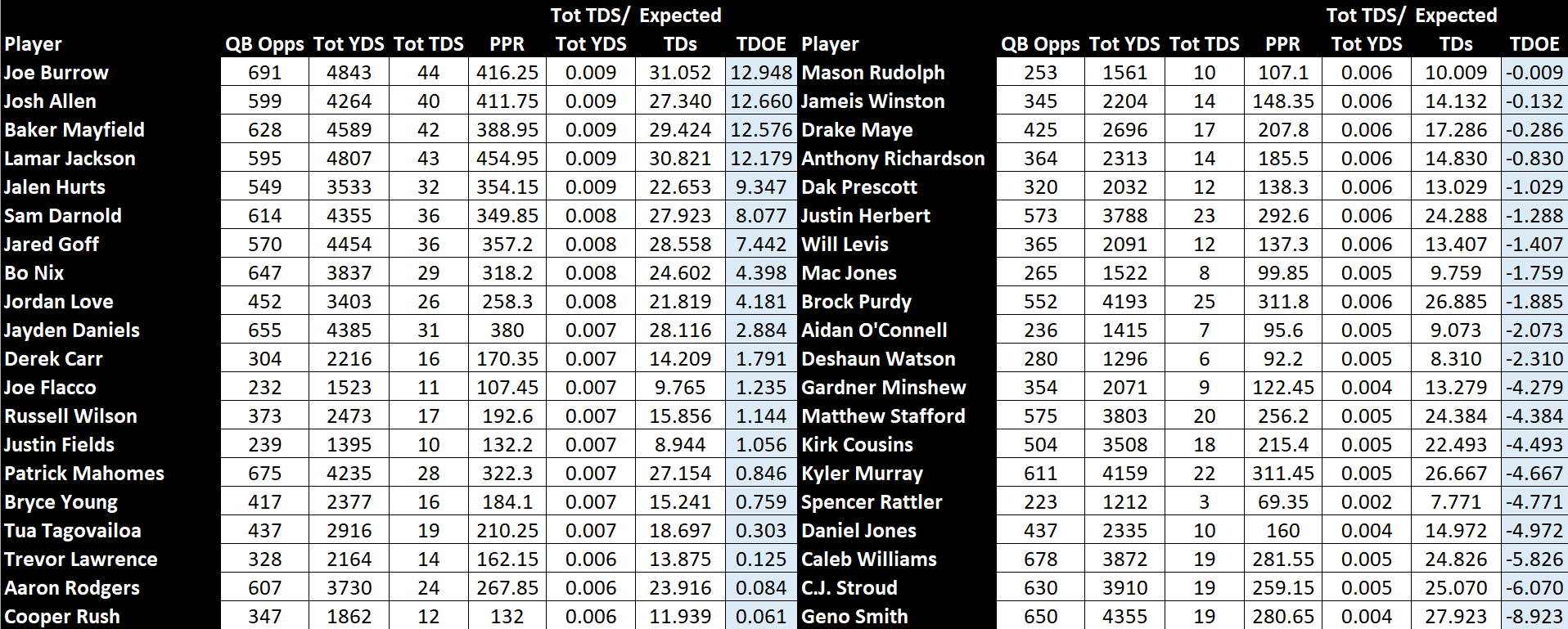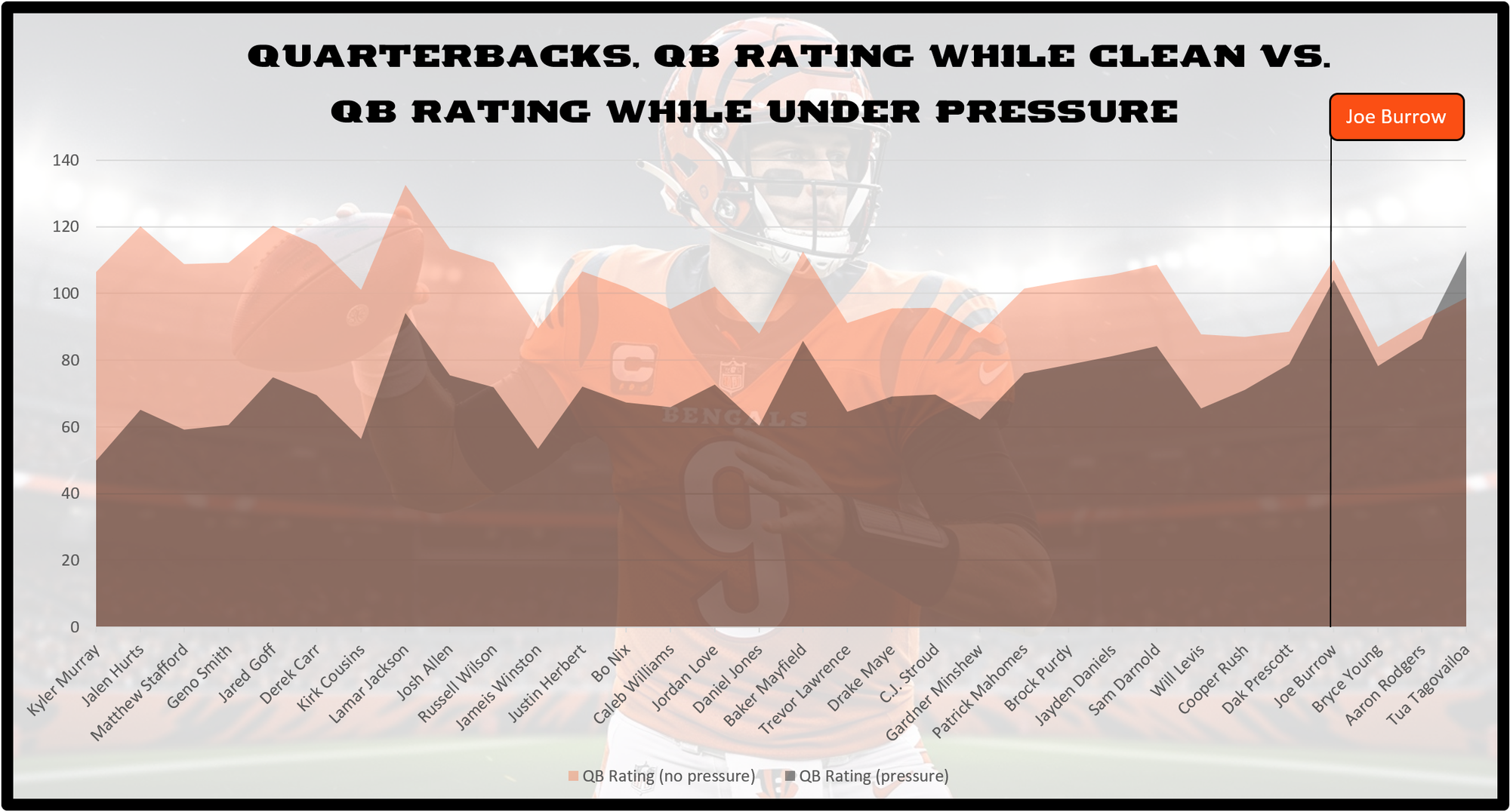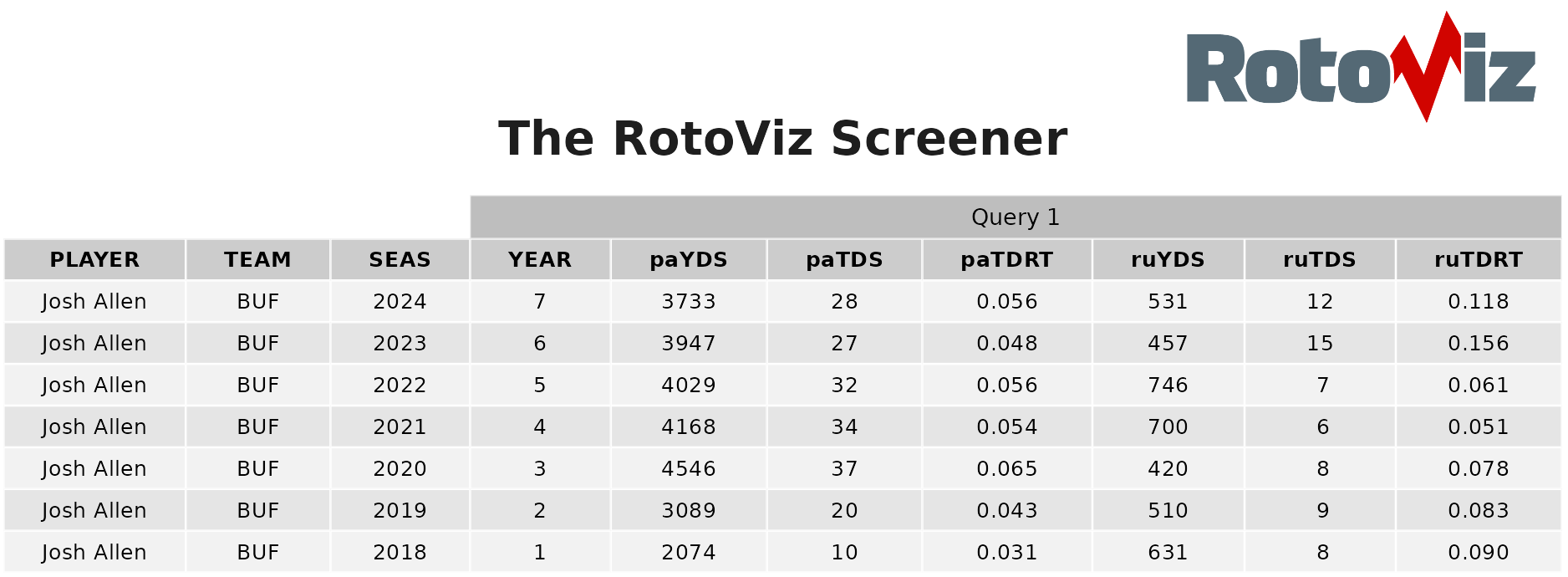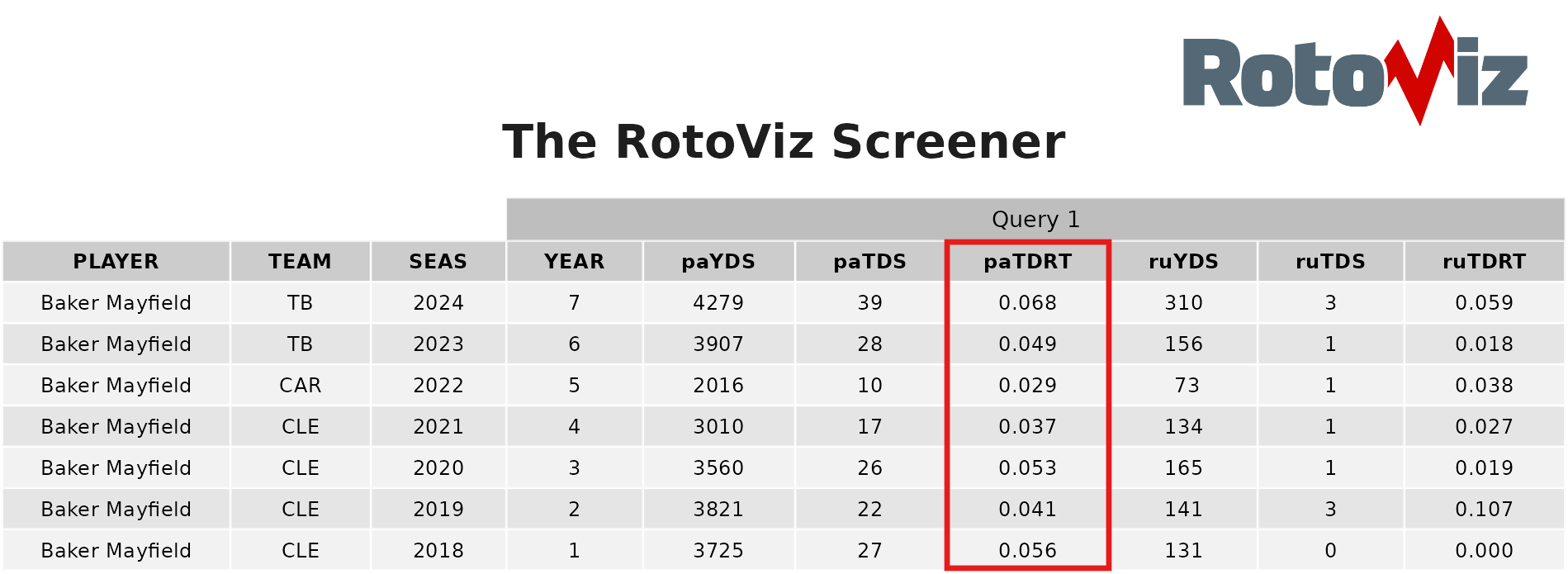
A Framework for Correctly Applying Regression and Studying the Outliers from 2024, Volume 1: Quarterbacks
I can’t write about regression to the mean in fantasy football without thinking of Ben Gretch’s Substack article, If I Never Hear the Word Regression Again, It’ll Be Too Soon. Blair Andrews’ Why You Shouldn’t Believe in Regression to the Mean plays on misconceptions about the concept, while his seminal piece, Good Players Are Good: Why You Should Chase Rookie-Year Efficiency at RB fundamentally changed my approach to fantasy football.
These articles all reinforce a core truth: supremely talented players consistently surpass statistical means.
Why? Because they’re better than average.
But then how do we reconcile this with elite analysts like Rich Hribar and J.J. Zachariason, who use regression analysis to great effect?
First, regression isn’t the soup—it’s an ingredient. Analysts use it in conjunction with many other data points, not in isolation. Second, regression has value but is often overstated or misused. Many wrongly treat it as a cosmic balancing act, assuming a player outperforming expectations must inevitably crater below the mean to even things out. That’s not how it works. Finally, within normal margins, regression signals aren’t particularly strong. The real value comes when applied to extreme outliers—a nuance often overlooked.
If you consume a lot of regression-heavy analysis, you may lose context and start seeing past TD production as a red flag, conditioning yourself to avoid players simply because they’ve outperformed expectations. But, of course, that’s irrational. TDs are good—we want them. Heavily relied-upon, highly-skilled players often score them. Some athletes are naturally predisposed to scoring more due to their physical traits or team usage, and we should embrace that.
That said, TDs are simultaneously the highest-scoring and rarest events to factor into the fantasy scoring computation, making them a major source of volatility.
Statistical games always involve variance—whether in poker, baseball, or Monopoly, stochastic variables shift outcomes beyond our control. But honestly... this is what makes stat-based games fun. If fantasy football were entirely predictable, it’d be like playing with dolls, scripting every action without resistance. The uncertainty is what brings the game to life.
Variance has a high end and a low end. Between these two is the most likely outcome. The larger the sample, the more results settle into their natural range, reducing variance outliers. Smaller samples, however, magnify volatility. A TE, with fewer opportunities per game, is inherently more volatile than a QB, who touches the ball on nearly every play.
Variance is deceptive. Flip a coin ten times, land heads eight, and it feels like a trend—until 100 flips remind you otherwise. Fantasy football operates under the same principle. A QB with 600 dropbacks plays a different statistical game than a TE with 60 targets. More volume means more data. More data means less room for randomness to masquerade as truth.
For QBs, extreme performances tend to self-correct. If Lamar Jackson throws five INTs over two games, we don’t assume he’s lost his touch. Jackson’s career sample is large enough to trust a more well-established and repeated pattern. Regression isn’t punishment—it’s balance.
TEs, on the other hand, operate in a world of limited opportunity. A handful of red-zone targets and a few broken tackles can shift someone like Hunter Henry from a waiver-wire dart throw to a must-start overnight. The issue isn’t TDs—it’s the lack of volume confirming sustainability. When production hinges on four targets per game, variance doesn’t just influence results; it dictates them.
So, what does this tell us? Simply put, larger samples reduce variance. When a player significantly outperforms expectations over a larger sample, correction becomes less likely. We receive a clearer picture of who he is.
Most readers understand that regression doesn’t mean a player performing at the high end of variance must swing to the low end. But when a QB is scoring 15 TDs over Expected (TDOE) and snaps back to zero—or five for an elite player predisposed to higher scoring—we’re going to notice. In a game where we seek every micro-advantage possible, a potential 3-6 points-per-game shift should demand our attention.
So, where could these edges be in 2025? Let’s look at the outliers.
THE OVERACHIEVING QUARTERBACKS
Let’s start with a little tutorial on how to interpret this table. All players in the table must have at least 200 QB Opportunities (passing + rushing attempts) to qualify. Total YDs and TDs combine passing and rushing stats. To the right of PPR, TDs/YDs is rounded to the thousandth to be less overwhelming. The league base rate is the average of these values.
Expected TDs are calculated by multiplying the league base rate by a player's total yardage. TDOE is the difference between actual and Expected TDs. The result is a z-score, where values further from zero indicate stronger outliers, with roughly half above and half below zero.

JOE BURROW (Underdog QB5)
Joe Burrow is the biggest outlier among QBs relative to the mean. As a pocket passer, he’s more affected by TD volatility than rushing QBs, making him a prime regression candidate by the letter of the law.
His 2024 TD rate hit a career-high 6.5%, half a percentage point above his legendary sophomore season. Either he overperformed in 2025 or he’s leveled up—this is the perpetual tug-of-war in regression evaluation, interpreting the difference between breakout and overperformance; and unfortunately, the answer is an educated guess at best.
Could Burrow maintain a 6.5% career TD rate? It would give him the best TD rate of the modern era—although just barely. Is he good enough for that distinction? Possibly. Is that likely? Obviously not. It’s never likely to declare any player should be the best in any statistical category in a sport with decades' worth of stats.
Why was 2024 so good? Was his much-maligned offensive line suddenly better? In a word, no.
Burrow faced pressure on 34.2% of dropbacks last year, his second-worst rate, yet remained effective (the only season where he was more pressured was his sophomore campaign which led to a Super Bowl appearance). He had the fourth-lowest QB rating disparity between pressured and clean-pocket throws (min. 300 dropbacks), reinforcing that he’s largely unaffected by pressure.

In his shortened 2023 season, Burrow started slow before regaining form around Week 5. His aDOT dropped to 6.9—his lowest ever. This was while recovering from injury, which seems relevant, especially as his aDOT rebounded to 7.7 in 2024, very near his 7.9 career average.
If we try to accept Burrow’s career highs as the new normal, the question becomes: are we accepting an outlier TD rate because he’s truly exceptional, or are we falling into a trap? Similar cases were made for Brock Purdy, Dak Prescott, and Russell Wilson last year, and all regressed. Is Burrow different?
Hall of Famers and future Hall of Famers like Drew Brees, Tom Brady, and Aaron Rodgers fluctuated some but often repeated near the positional apex. Burrow’s trajectory suggests he belongs in that tier. Given his age and longevity at QB, he remains a blue-chip dynasty asset and should likely not be sold at or below market, even if rebuilding.
Based on his ADP at Underdog as the QB5, Burrow slots just below the elite rushing crop, which feels right. However, we should recognize that he is much more likely to drop to the middle than the QBs who go before him, so we may plan accordingly if we seek a high-end QB in this range, considering Burrow a tier below.
JOSH ALLEN (Underdog QB1)
Joe Burrow flirts with outlier status, but Josh Allen is the outlier. In seven seasons, Josh Allen has posted a TD rate of 5.4% or higher four times, with last year’s 5.6% his second-highest. His 2024 rushing TD rate was also the second-highest of his career, as the reigning MVP outscored all but seven RBs on the ground in 2024 and all but one in 2023. He trails only Jalen Hurts in QB rushing TDs over the past two seasons.
Allen’s goal-line role sets him apart from rushing QBs like Lamar Jackson and Jayden Daniels, while his passing volume separates him from Hurts, Anthony Richardson, Bo Nix, Justin Fields, and Kyler Murray. This rare blend gives him one of fantasy’s most reliable floor-to-ceiling combos.
He’s been a fantasy powerhouse for five straight years, finishing third, first, first, first, and third in PPR/G. He ranked in the top two in EP for four seasons before dipping to seventh as James Cook’s goal-line role expanded last year. He’s also been in the top two in FPOE for three straight years. Simply put, he’s the most reliable thing in fantasy.

Allen should not be faded in dynasty, best ball, or redraft. His consistent dominance over multiple seasons warrants a realistic expectation that he will continue exceeding league-average TD rates annually.
GMs willing to place Allen first in dynasty ranks could potentially value Jackson, Hurts, or Burrow ahead of Daniels if they prefer a more proven veteran, but no veteran should usurp Allen on these grounds. Uniquely, the only other legitimate choice as dynasty QB1 overall then becomes Daniels if a GM heavily values youth and market value. It must be one or the other at the top of the board; no one else makes sense.
BAKER MAYFIELD (Underdog QB7)
Baker Mayfield is one of the clearest candidates for negative TD regression this off-season. It’s clear by now that he was underrated during his time in Cleveland, Carolina, and as a backup in Los Angeles, and it's a positive that his public perception has improved. However, his TD rate from last season is unsustainable.

Lamar Jackson holds the highest career TD rate among active players (6.4%), according to Pro Football Reference. Aaron Rodgers is at 6.1%, Patrick Mahomes at 5.9%, Russell Wilson at 5.8%, and Joe Burrow at 5.5%. While Mayfield’s 6.8% TD rate is impressive, it dwarfs his second-highest season-long rate at 5.6%, set in his rookie year. All of these factors inform us his 2024 rate is bound to crash.
To further complicate things, his former offensive coordinator, Liam Coen, is now the HC in Jacksonville. And while Mayfield is a decent scrambler, he also significantly exceeded his career average in rushing TDs last season. Mayfield is not really a rushing QB; like Burrow, he’s a pocket passer who is a capable rusher. Pocket passers are more susceptible to regression than high-volume rushers like Allen.
All signs point to Mayfield regressing to his career TD totals in the mid-to-high 20s rather than sustaining a near 40-TD pace. He also surpassed his career passing and rushing yardage averages in 2024, which should dip as well. Given this, Mayfield seems primed to be overvalued in 2025, and at a QB7 price, I’ll fade him.


